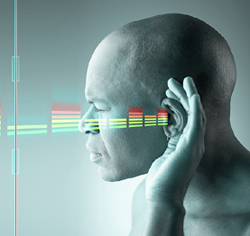
Examples. Let’s put some of the above into practice. A 100 mm (approximately 4 inch) diameter loudspeaker radiates 1 Pa acoustic pressure (94 dB). The resulting volume velocity (U) can be determined by solving for the particle velocity (u) using equation 1 and then solving for the volume velocity using equation 5. Solving gives us a volume velocity of 1.9 x 10-5 m3s, a very small quantity indeed.
Assume we substitute a 400 mm (approximately 12 inch) diameter loudspeaker that radiates the same acoustic pressure. Using the calculations for the 100 mm loudspeaker example results in a volume velocity approximately a factor of 10 larger, 3.1 X 10-4 m3s.
When the guitarist in the band cranks his amp to “11” and the output increases to 120 dB, the volume velocity with the 12 inch loudspeaker is still surprisingly small at 6.1 X 10-3 m3/s, approximately a factor of 100 larger compared to the 1 Pa (94 dB) output.
The acoustic impedance for the 100 mm loudspeaker radiating 1 Pa acoustic pressure is 5.3 X 104 Pa s/m3 and is 3.2 X 103 Pa s/m3 for the 400 mm loudspeaker. Note the lower acoustic impedance for the larger loudspeaker indicating more efficient acoustic radiation.
The 100 and 400 mm loudspeakers, each radiating 1 Pa acoustic pressure, result in a sound energy density of 7 X 10-6 J/m3 for each as determined using equation 4. Again, like the particle velocity and volume velocity, the sound energy density is extremely small.
You will notice that even though we are dealing with relatively high SPL values, 94 and 120 dB, the physical acoustic variables, excepting acoustic impedance, are fairly infinitesimal. This indicates the extreme sensitivity of our hearing mechanism.
I encourage you to take your time in digesting this information. No one becomes a scientific guru of sound overnight. However, your time will be well invested, because this information is truly at the heart of everything you do when working with sound.
Neil’s Rules Of Thumb For Calculating The Basics:
—The reference acoustic pressure, 20 μPa, results in 0 dB SPL, the threshold of audibility.
—The motion of the ear drum due to a 0 dB SPL at 1,000 Hz is less than 1 angstrom (10-7 mm), the diameter of a hydrogen atom.
—A value of 1 Pa acoustic pressure will result in 94 dB SPL. This pressure value is commonly used in acoustic calibrators.
—Each successive doubling of acoustic pressure increases the SPL by 6 dB.
—Most physical acoustical parameters are very small quantities even though the SPL is relatively high.
